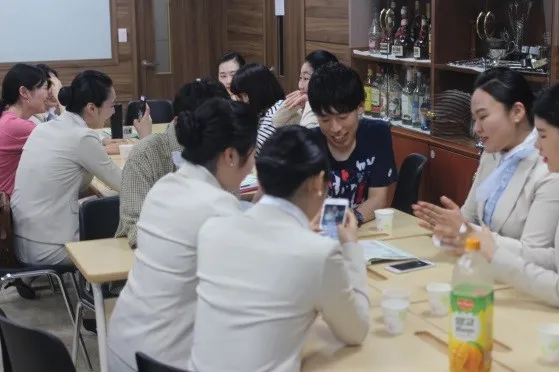2016 Activity Report
March Activity Report
March 2017
Global Japan Office Coordinator
AHN Soyon
Last month, news related to Jeju Air charter flights between Incheon and Fukushima attracted much attention. Due to fearing health risks related to the Fukushima Daiichi nuclear disaster, crewmembers were successively refusing to work on the flights, and concerns were also raised by passengers. Ultimately, Jeju Air announced that they would be changing their flights’ destination form Fukushima Airport to Sendai International Airport. Following this piece of news, there was increased interest in Sendai, I received many questions as to whether or not Sendai is safe from radiation, and in response I had an acquaintance introduce me to the head of the Miyagi Prefecture office in Seoul.
I immediately made an appointment to visit the Miyagi Prefecture office in the centre of Seoul, where I received a warm welcome from the office head and staff members. When I told the head about the questions that often came from the university students, I was first of all shown a webpage where you can check the levels of radiation and radioactivity in Miyagi Prefecture in real time (http://www.r-info-miyagi.jp/r-info/ko). Aside from of course Japanese, it can be viewed in Korean, English and Chinese, so even students who don’t know Japanese will be able to get information there. In addition, it compares the amount of radiation with areas far away from Fukushima, so it was clear that we were completely safe form the radiation and radioactivity that everyone is most anxious about.
Also, I was introduced to things like the rich food culture in some of Miyagi’s tourist spots that are lesser-known in Korea such as Matsushima, one of the three famous beauty spots in Japan, and Zao. I took up about two hours of their time, but I think that Miyagi is an area so abundant with cuisine and places of note that it was too much to hear all of it. The office head couldn’t explain all of it in one day either, so they told me about the sightseeing navigation website created and run by Miyagi Prefecture (https://www.pref.miyagi.jp/site/kankou-ko/) and the Seoul Miyagi Prefecture office website (http://www.miyagi.or.kr/).
If you want to know about Miyagi prefecture you can contact the office by telephone, and those who wish to do so can visit the office to hear explanations, and in the case of large groups of people, the office head will visit schools to give an introduction to Miyagi. I always want the students to receive tourism information without coming into contact with false information on the internet, so I am very thankful for these suggestions. We both agreed that we would like to collaborate if there was anything we could work on in order to spread correct information from the GJO Seoul office. I send my thanks to the Miyagi Prefecture office for our long discussion.
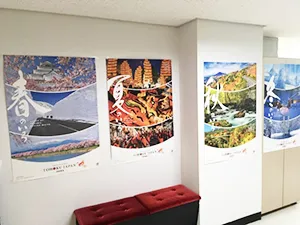
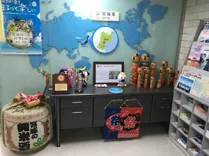
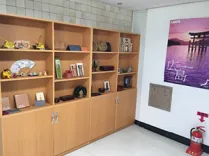
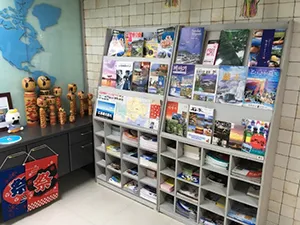
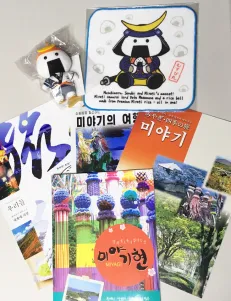
February Activity Report
February 2017
Global Japan Office Coordinator
AHN Soyon
Last month, I introduced the students to the offices of each area in Korea. Before going to their travel destinations, the students went to the offices and picked up tourist pamphlets and travel guides, but apparently the offices were very quiet and it was difficult to speak up and ask questions (laughs). Even so, I hear that the pamphlets were helpful for their trips, and that there were pamphlets not just for travel information but also for information on the locations, so they could learn about their travel destinations, which was good. I thought that from here on it would help with things related to information on locations, so I went to see each of the offices.
1. Nagasaki Prefecture Seoul office
The Nagasaki Prefecture office is located in Gwanghwamun in the centre of Seoul. I just went for a look, so I didn’t make an appointment, but the head of the office kindly spent a long time telling me about Nagasaki prefecture and the activities of the office. Because the Nagasaki office and GJO share the common objective of promoting Japan in Korea, we decided to contact each other if there is anything we can collaborate on in the future. The Nagasaki office is part of the Seoul Council of Local Authorities for International Relations, and aside from Nagasaki there are staff from Ibaraki Prefecture, Toyama Prefecture, Kyoto Prefecture, Tottori Prefecture, Miyazaki Prefecture, and Kagohsima Prefecture, and you can receive information on each prefecture at any time.



2. Shizuoka Prefecture Seoul office
About a 5 minutes’ walk from the Nagasaki office, the Shizuoka office is located near the Seoul municipal office. Just as the students had said, there was a very quiet atmosphere, but when I called out, the office’s deputy head came to me with a smile. Handing over my business card, I explained the GJO and its activities, and the deputy head introduced me to Shizuoka Prefecture and the office’s activities. There are Korean staff at Shizuoka Prefecture Seoul office and you can speak to them in Korean, so you can freely go and ask questions



3. Okinawa Prefecture office
Located next to the Nagasaki Prefecture Seoul office is the Okinawa Prefecture office. It has been introduced by Yoshihiro Akiyama, who has appeared in Korean variety shows, and it is known as a tourism destination. There was a wealth of tourism guide pamphlets. They are laid out on a table, so you can browse them at your leisure.



4. Niigata Prefecture Seoul office
The Niigata Prefecture Seoul office is located a 3 minutes’ walk from the Shizuoka Prefecture office, and an 8 minutes’ walk from the Nagasaki Prefecture office. The space in the office is more open than the other offices and it is easy to speak up. Yasunari Kawabata’s short story ‘Snow Country’ is famous in Korea too, and a pamphlet promoting Snow Country stood out.




If you visit the webpages of each office, they are mainly for distributing information on each municipality, so if the GJO could earn the offices’ cooperation through those activates, I think we might be able to work on transmitting more specialised information. So, I am very thankful to have been able to actually go and meet the staff at these offices and tell them about GJO, and to ask for and receive their agreement to collaborate. In particular, there were municipality events asking for the participation of lots of Korean university students, so if GJO could be of use I would definitely like to collaborate. From here on, I hope for us to lend each other our abilities and create a larger synergy.
January Activity Report
January 2017
Global Japan Office Coordinator
AHN Soyon
From December to the end of February is the winter holiday, and so the school is deserted. Also, in January is the one of the biggest national holidays in Korea, New Year’s Day.
New Year’s Day in Korea comes after the solar New Year, so most years it occurs between the middle of January to the beginning of February, but this year was a short, four days’ holiday from 27th to 30th January .
As for a traditional Korean New Year, the motorways and KTX (the equivalent to Japan’s bullet train) stations being crowded with people returning home to spend the New Year with family they don’t usually get to see used to be a typical scene. However, recently that has been changing, and airports have been crowded with people going on trips instead of returning home, because more families have been using the New Year holiday to travel abroad. Because this year’s holiday was only four days long, it seems that nearby places like Japan, China and Southeast Asian countries were popular.
There were some students were going on family trips to Japan at the New Year, they asked about making travel plans at the Seoul office. They basing their plans off guidebooks and the internet, but most of those were aimed at tourists, so they mainly just on places where lots of tourists gather. The students wanted to be shown more out-of-the-way places that inhabitants of those areas recommend. However, since neither they nor I are from those areas, we were lacking information on less well-known places. So, I introduced them to the Japanese prefecture offices in Seoul, which employ staff from those prefectures in Japan. Beginning with the Seoul office of the Japan National Tourism Organisation, which summarises tourism information for the whole of Japan, I introduced the offices of Miyagi Prefecture; Hokkaido prefecture and the three northern prefectures of Tohoku; Niigata Prefecture; Nagasaki Prefecture; and Shizuoka Prefecture, which all have offices in Seoul for the purpose of spreading information on each prefecture in Korea. All of the offices are located in the centre of Seoul and are easily accessible, and since they house staff members who are sent out from each prefecture, the students can ask citizens of the areas they are researching about hidden gems. I also told them that the offices, aside from information tourism, they have abundant information on the regions, and have detailed pamphlets produced by each prefecture, so if they had a look through them before their trips, they would be able to enjoy Japan all the more. I hope that they make many memories of great experiences of the kind that can’t be learned from guidebooks.
December Activity Report
December 2016
Global Japan Office Coordinator
AHN Soyon
On 4th December, the Japanese-Language proficiency test (JLPT) was held in Seoul. The students who have been gathering to study in the library for long periods and coming to ask at the GJO when there were problems they couldn’t solve were able to exhibit the skills they have built up so far in the test. They want to relax now that the test is over, but they were anxious that doing nothing but have fun would mean that the knowledge they’ve accumulated so far would begin to slip away, so they came to ask if there was a way to have fun while still holding on to their Japanese.
Memorising verb conjugation is the hardest part and even now there are those who don’t understand it fully, so when I suggested a fun card game to help remember verb conjugations everyone gladly accepted the proposal.
We prepared three sets of cards containing orange-coloured noun cards with simple vocabulary; pink adverb cards; green verb (in dictionary form) cards; and white grammar cards. Then, I hosted the following game.
*Small group activity
1. We split into three groups of three players chosen at random.
2. We then dealt out the verb cards to each group. We looked up and made ourselves familiar with the meanings of the vocabulary on the cards, and split them into godan, ichidan, and irregular verbs.
3. Then, we dealt out the grammar cards to each group. We looked up and made ourselves familiar with the meanings of the grammar on the cards and their modified forms when used with verbs.
4. We practiced verb conjugation by each taking a verb card one by one and explaining to the other two in the group how the verb from changes to fit with each grammar card. If anyone made a mistake, other members of the group would correct them.
5. We then dealt out the noun and adverb cards to each group. We checked and made ourselves familiar with the meaning of the vocabulary on the cards.
6. We then tried putting the cards together to make sentences.
*Whole group activity
7. We went over the adjectives and verbs that use different particles to Korean, for example ‘~が好きだ’, ‘~が下手だ’, ‘~に~てほしい’ etc.
8. As host read I out a sentence in Korean, and the team that created the sentence in perfect Japanese using their cards the fastest was the winner.
Because Japanese and Korean have many aspects in common, such as word order, it’s said that Japanese is easier to learn than other languages. However, there are surprisingly many instances where the use of particles is different. Because of that, perhaps because we deliberately didn’t prepare the particle cards, in the eighth activity there were surprisingly many particle mistakes that kept coming up, and it took a while before they got the right answers. Even though it went on for about two hours, I didn’t see anyone get tired and everyone was absorbed in the game until the end. Once the game had finished I asked everyone for their thoughts.
-This was the first time I’ve studied Japanese using a game. Even though we were just playing a game, I was able to study and have fun in a fresh new way.
-I didn’t do as well as I’d hoped in the test and was feeling tired of Japanese study, but I enjoyed this game and feel motivated again.
-I had to repeatedly check the cards, so I kept seeing the vocabulary and grammar many times and naturally was able to memorise them.
-I don’t think I’ll forget the vocabulary and grammar I learned in the game.
-It’s strange that I was able to memories the conjugations and vocabulary that I just couldn’t memories before in 2 hours.
-If I use this method of study I think I’ll be able to continue to N1 level.
-I’m very competitive, so without realizing it I became intent on not losing to the other team (laugh).
-Until now I’d been learning things by heart by myself so it felt a bit lonely, but today I had fun collaborating with everyone as we were able to teach each other and put our efforts together.
-From now on I want this to be a regular thing, going over the content of our studies using games. I want to play the game again.
-I wish I’d asked if there was a fun way to study like this before I took the test… I would have got a better grade if I had.
You could say that studying a foreign language is a personal battle, and that Language proficiency exams are a critical point. At such a critical point, if you can’t take a break and refresh, it can lead to you losing your grip on your studies. Nevertheless, by studying through this game students who were worn out were able to feel refreshed and once again feel motivated to make an effort, and I feel happy that planning this game was worth doing.
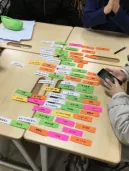
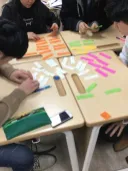
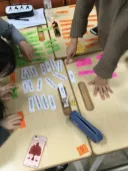
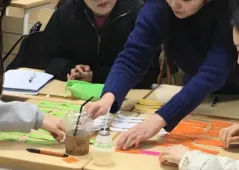
November Activity Report
November 2016
Global Japan Office Coordinator
AHN Soyon
These past few years, the question I’ve been asked most about Japan is about radioactivity. Since the Tohoku earthquake of 2011, aside from the decrease in tourists and international students, the number of people avoiding Japan-made food products, makeup, and particularly products for babies has risen considerably. What’s more, even in Korea, where people have come to think they are safe from earthquakes, In Gyeongju, which isn’t far from nuclear power plants and where earthquakes occur one after another, concern about the Fukushima nuclear power plant disaster and earthquakes has risen once again. Korean Broadcasting System (KBS) aired a documentary featuring children living in temporary housing in Fukushima Prefecture titled ‘Tofu House- living in Fukushima’ (original title: 두부하우스-후쿠시마에 산다는 것은), so I decided to show it to and hold a discussion on earthquakes with students who had shown an interest in earthquakes and nuclear power. Afterwards, I took the opportunity to show ‘Japan’s Many Earthquake Countermeasures’ from ‘Correspondent Report World Now’ of the same broadcaster.
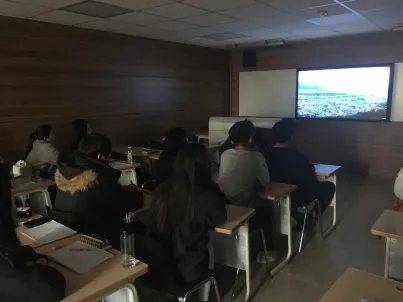
The film focused on Fukushima temporary housing residents Yuki and Misaki. There was to be a special performance of a concert put on every year in Fukushima by a Korean artist, and the documentary started from the time Yuki wrote while a Korean composer applied a melody with a group of Korean children.
Yuki and Misaki used to live in Namie, Fukushima, but after the earthquake occurred when they were 7 years old, they moved to shelters before settling in temporary housing. They named their white, rectangular temporary accommodation “Tofu House”, and introduce their way of life in temporary housing. Yuki and Misaki’s fathers also make an appearance and share their thoughts about the hometown where they lost their family and of which only traces remain. Darker topics such as the discrimination against evacuees even within Fukushima were also covered.
The Korean children singing the melody introduced first Yuki, then Misaki, in the footage. While listening to their song, ‘Tofu House’, everyone took another look at both sides of the story. The problems of nuclear power remain to this day, but things are gradually improving, and I believe that our children do have a future.
After watching the film of over 50 minutes, some students were moved to tears. We had set aside 30 minutes for questions and comments after the film, but ended up running over to more than an hour. Everyone commented together “until now I had only though about the danger of radioactivity and I didn’t have any interest at all in the victims. But through this documentary I’ve come to see another way of looking at natural disasters”. I’ve never been asked many questions besides those on fears on the dangers of radioactivity, such as “is it okay?”, “is it not dangerous?”, “can we believe the presentation from the government?”, or “I heard a ghost story about radioactivity, but is it true?”. However, I was able to make sure that the roughly 20 people who came to watch this documentary changed their view of the Tohoku earthquake. I think the 50 minutes spent watching that documentary were very meaningful indeed.
[Questions and Comments]
-When can the people lining in temporary housing return to their hometowns?
-Would it have been better to build the temporary housing a little further away from where the earthquake occurred?
-Will they not receive any financial aid from relatives living in other areas to rebuild their homes? (In Korea, there is a tendency to place great importance on blood relations after marriage, which is why such a question was asked)
-Is it known in Japan that bullying and discrimination even in Fukushima is a danger of nuclear accidents?
-The narration saying “don’t forget about helping them, keep them in mind” really resonated with me.
-Until now we thought it was just us who were harmed by the radiation. Now I will reflect on the fact that there are evacuees who can’t return home and take a fresh look at the Tohoku earthquake.
-Korea too isn’t safe from earthquakes anymore, so I think we should implement systems like the ones in Japan.
-I admire the ideas of Japan.
-I think it’s amazing how Japanese people are able to respond so calmly in the event of an earthquake since they undergo earthquake training since childhood. In Korea, you can apply to take earthquake training at the right facilities, but I want them to enforce compulsory training.
-I come from Gyeongju, and I want the Korean government to learn from Tokyo Electric Power Company and take measures against nuclear power soon.
-The experts say that the half-life for radioactivity is 30 years, but I hope Yuki and Misaki are well for longer than that.
-The stories of people who had lost their families and had neither the body nor a single photograph to remember them by were sad. I wish they had even just one item to remember them by.
-I have no interest at all in the actions of the Japanese government towards Korea, but as a fellow human being my heart aches over the lives of the victims. When I think of what I might have done were I in their position, it’s too sad and too painful to bear.
-When the Tohoku earthquake occurred, I couldn’t understand why the Korean government sent financial aid over to Japan, but after watching this documentary I’ve reflected on my thoughts. I want the area to be restored.
-More than anything I felt sorry for the children, but I was relieved to see them living cheerfully.
October Activity Report
October 2016
Global Japan Office Coordinator
AHN Soyon
On 2nd October 2016 I went to the Korea-Japan Festival which was being held at COEX Mall in Seoul. The Korea-Japan Festival is cultural exchange event that has been held annually in Japan and Korea since 2005 to commemorate 40 years since the normalisation of relations between Japan and South Korea. It is a large-scale event aimed at mutual understanding and respect between the two cultures, in which anyone can take part regardless of sex, nationality or age.
As a matter of fact, I received a poster for the Korea-Japan Festival on my visit to the Japan Information and Culture Institute, which i displayed in the office. There were many students who showed an interest and came along to this year’s festival.
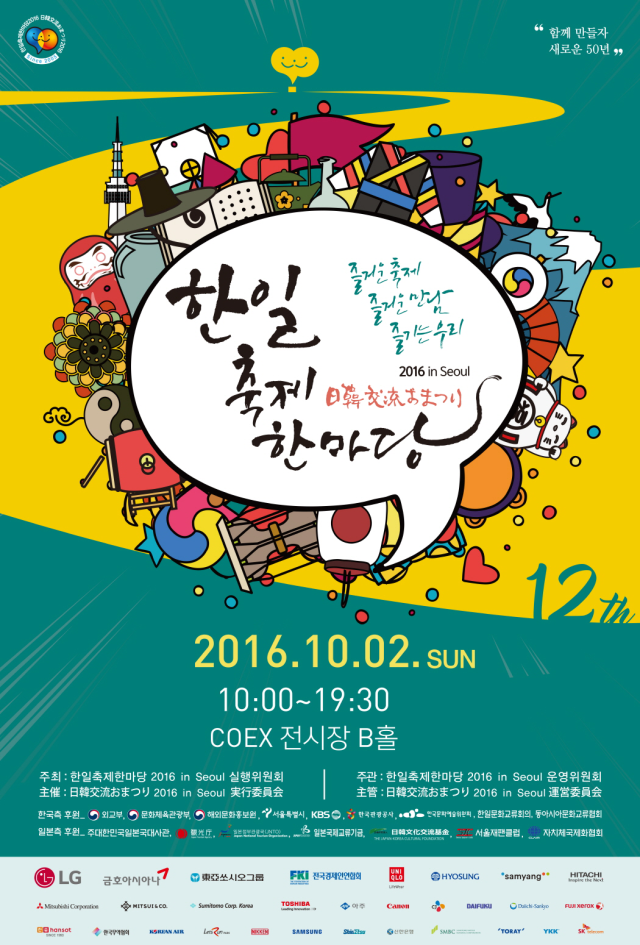
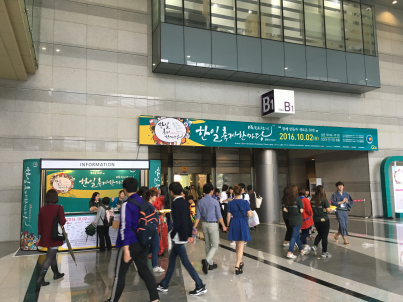
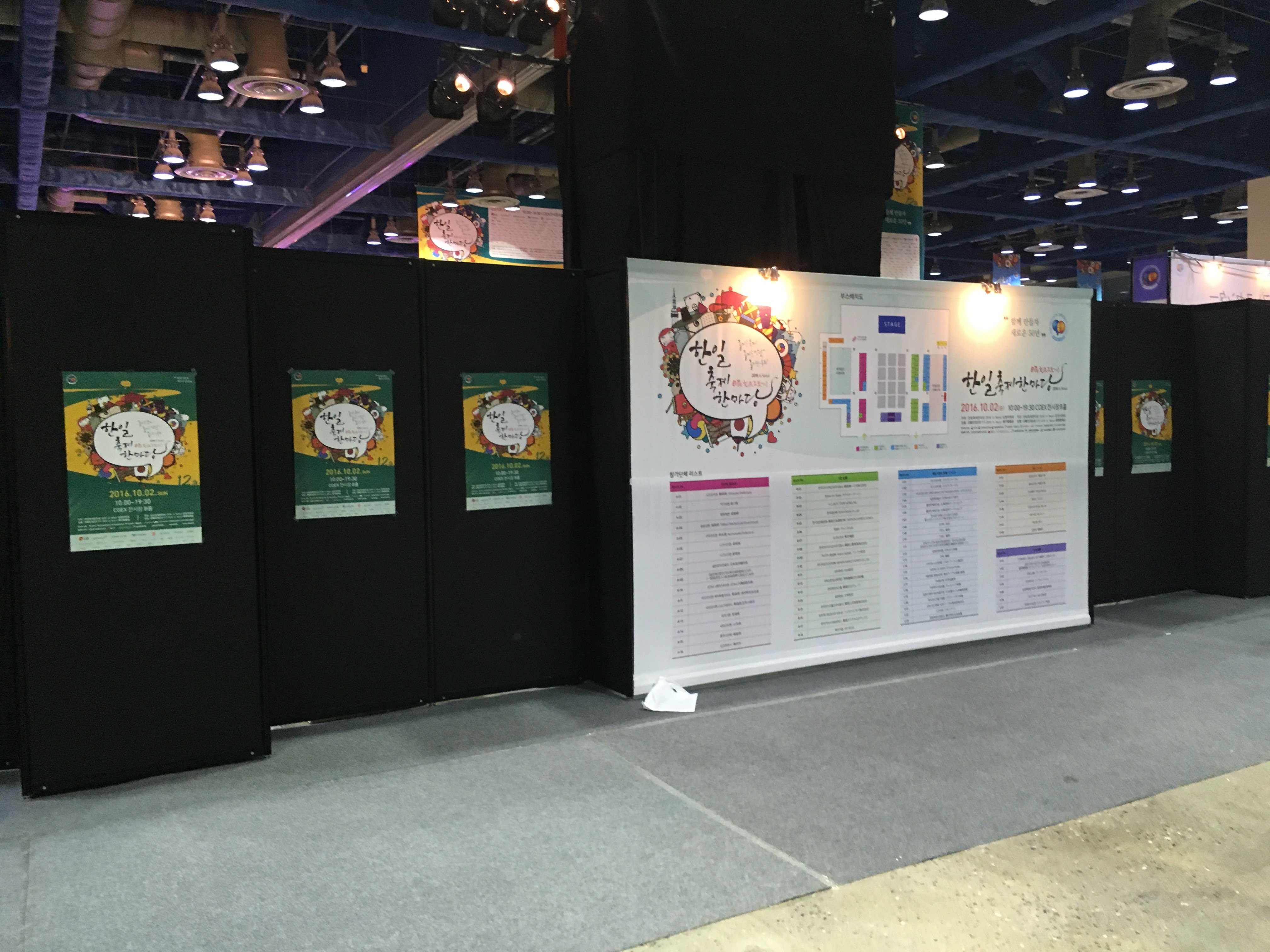
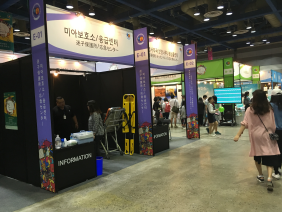
*The Stage
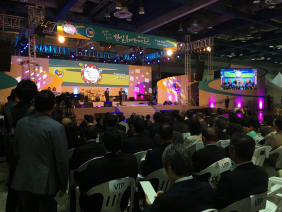
*Local Government Booths
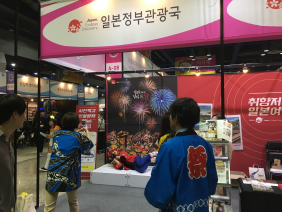
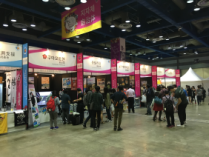
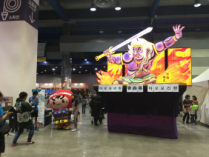
*Company Booths
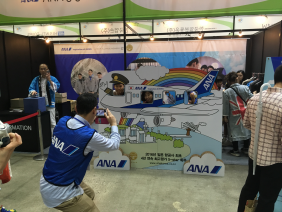
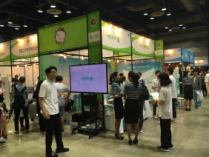
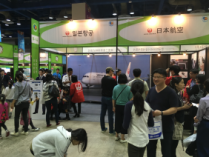
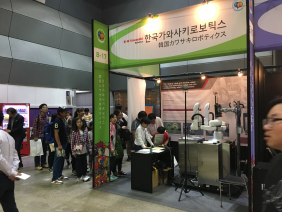
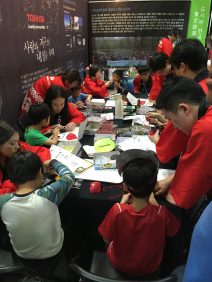
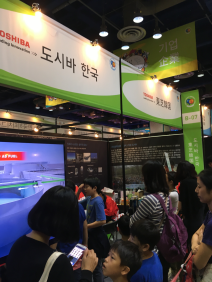
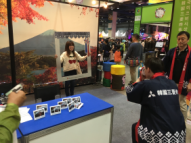
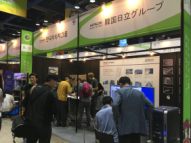
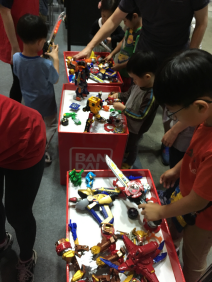
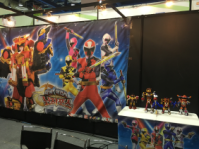
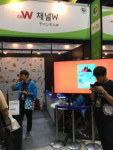
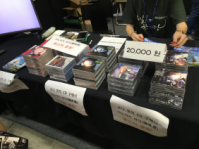
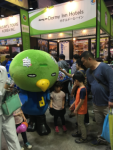
*Experience Event Booths
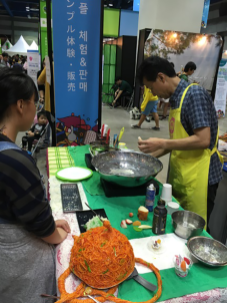
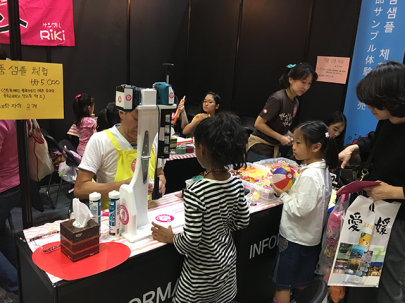
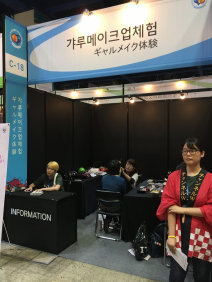
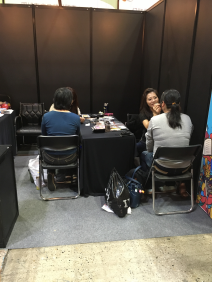
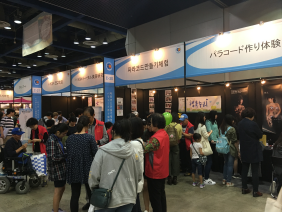
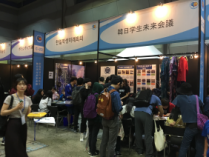
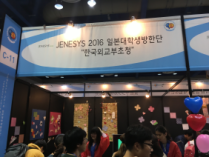
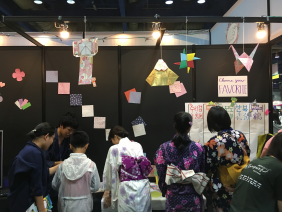
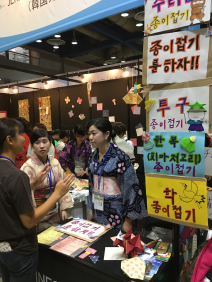
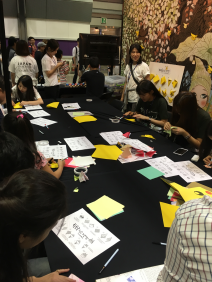
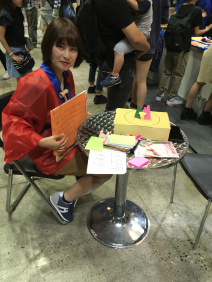
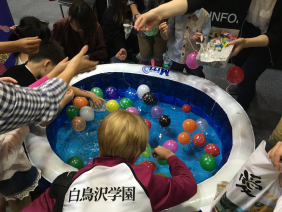
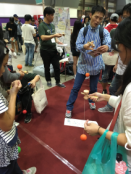
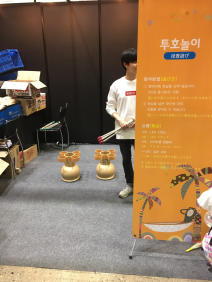
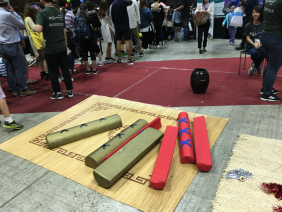
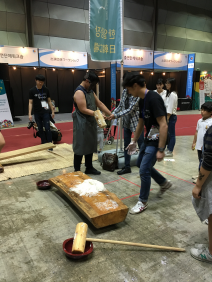
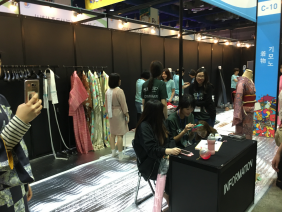
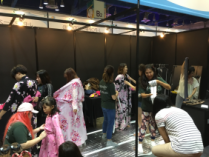
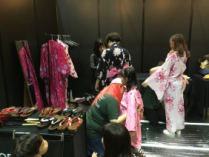
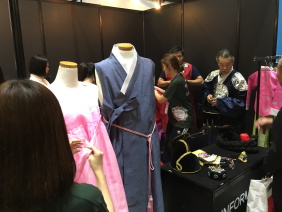
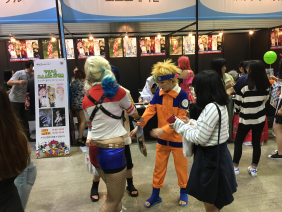
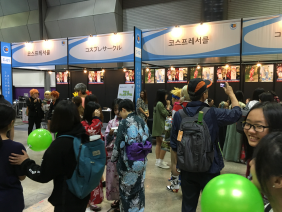
*フード・販売ブース
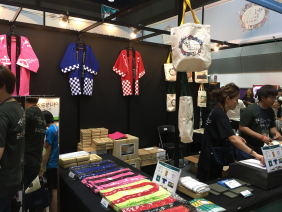
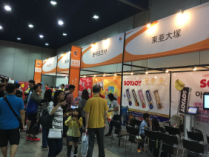
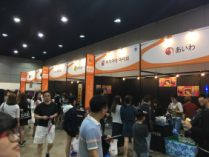
Since it was a festival in which Japanese and Korean governing bodies and corporations were participating, the scale was far bigger than other Japanese culture events, and it was attractive as an event full of merchandise and projects where visitors could see, do and eat many different things in one day. There were lots of Korean people attending, but there was also a surprisingly large number of Japanese visitors, and seeing them all mingling at the booths really gave the feeling of a cultural exchange festival. Even when there were language barriers, I think that being able to communicate by using gestures and just trying one’s hardest to explain things will be a special memory for both sides. Even in the midst of poor Japanese-Korean relations, I’m glad that the citizens have been able to continue these exchanges for the past 12 years.
*Students’ comments on the Korea-Japan Festival.
- I think I will remember how the Japanese people explained traditional games to us I Korean and kindly took photos for us.
- It was good how there were lots of photo zones, and you could try on kimonos and take photos with cosplayers. I’m happy to have so many memories to post on Instagram.
- Japanese canteens are popular in Korea, but it was good to be able to taste the real thing.
- It was good being able to experience traditional Japanese culture that you wouldn’t be able to experience on a trip.
- Experiencing games that I had played as a child once again as an adult was a unique and enjoyable experience.
- Even when we couldn’t communicate through words we were able to play games together. I think that language isn’t always necessary for mutual cultural understanding.
- There are both activities that resemble those in Korea (such as origami, toko and mochi-making), as well large differences between the two countries, but I think that we exist in the same cultural sphere that shares a lot of points.
- It was good being able to see Japanese entertainers perform up close.
- It’s a shame it was over in one day. All the Japanese staff were very kind.
- This was the first time I’ve seen so many cosplayers up close. It’s a shame that there isn’t any Korean anime cosplay.
- I didn’t understand the traditional performances. I’d like them to explain what the dances before the performances mean.
September Activity Report
September 2016
Global Japan Office Coordinator
AHN Soyon
In Korea there is a Japan study abroad fair held every year, and this year it was held at Busan’s BEXCO on the 10th September and at Seoul’s SETEC on 11th September. Many of Japan’s universities are well-known in Korea, and it is already attractive as a study abroad destination, but following the Tohoku earthquake its popularity decreased among international students. However, now the number of students studying abroad in Japan is on the increase. The venue was busy with students interested in studying abroad in Japan.
The venue was only a minute’s walk form the underground station, and the road between was full of people advertising schools for Japan study abroad exams.





*Hosts and sponsoring organisations

Organisations sponsoring the Japan Study abroad fair.
Attendees could discuss all topics relating to studying abroad in Japan including school information, Japan study abroad exams, scholarships, and tuition fees, so there were parents and guardians arriving together with students.

Visitors could discuss vocational schools and Japanese language schools in general (including postgraduate studies and careers).

There was guidance available on visas, the JET program, and MEXT’s government-funded foreign student system. In particular, the venue was crowded form start to finish with people wanting to discuss how to receive government funding for tuition fees and maintenance costs.

There was guidance on Japan study abroad exams in general, including guidance on receiving enrollment permission prior to entering Japan as well as schedules for Japan study abroad exams, schools, and the system of promotion of learning for self-funded MEXT students.

People with experience of job-hunting activities in Japan during their study abroad answered questions about career courses and job seeking after graduating. Finding good employment is one of the goals of international students, so there were parents and guardians also coming for consultations.

Students currently studying abroad in Japan and those with experience studying abroad drew on their experiences to respond to questions. By relating information on living in Japan and their own experiences, they were able to reassure parents and guardians about letting their children study in a foreign country.
*Participating organisations (5)

House hunting or borrowing in a foreign country is fairly difficult. The main house hunting methods and conditions when studying abroad were being introduced.
*Universities and post-secondary educational institutions (63)




Students studying the arts form a long queue.


Long queues formed for information on ‘the most prestigious private universities’, ‘the scholarship system for studying abroad’, ‘the high employment rate prefers by businesses’, and ‘the many partner institutions in Korea’ among other things.


(they emphasise being a ‘national’ university)

Because they are widely-known as prestigious even in Korea, this was the longest line at the venue.
*Prestigious schools; Japanese schools (63)


Phrases such as ‘Finding employment in Japan’ and ‘Those who pass the JLPT are exempt from matriculation fees’ stood out.
The vocational schools booth mainly appealed with ‘finding employment’. As for Japanese Language schools, they provided guidance on things such as ‘short term study abroad’ programmes.
The questions often heard in discussions on studying abroad and training courses in Japan were those concerning finding employment and scholarships, for example ‘if I study Japanese, will it be useful in finding employment?’, ‘are there any systems to support tuition fees through scholarships?’. At this year’s fair too there were many people queuing for the booths to discuss finding employment and scholarships, so I was able to reconfirm the matters to be taken into consideration when thinking of studying abroad. In addition, I was able to find out which study abroad destination universities are well-known in Korea, and understand the preference among students to choose a university that most people have heard of.
In particular, short-term study abroad programmes are expanding in study abroad exam schools located in Korea, so I plan to promote short-term study abroad programmes at TUFS using social media.
The Korean edition pamphlets I received at the entrance provided information not only on studying abroad but also on life in Japan, so I will put them in the office for people to read at their leisure.
August Activity Report
August 2016
Global Japan Office Coordinator
AHN Soyon
1. Through talking with the people at the Japanese embassy in Korea’s Information and Culture Institute I learnt that there were people working at the Information and Culture Institute to encourage students to study abroad in Japan, so I had an acquaintance introduce me. I explained the role of GJO at the Information and Culture Institute to first secretary Shinoda Satoshi. Since there were areas in common with the work being carried out at the Information and Culture Institute, it was decided that from now on the GJO will be allowed to take advantage of events held by the institute that would be difficult for me to organize on my own, such as study abroad fairs and Japanese cultural festival events.
In addition, I received the privilege of viewing the inside of the Information and Culture Institute.
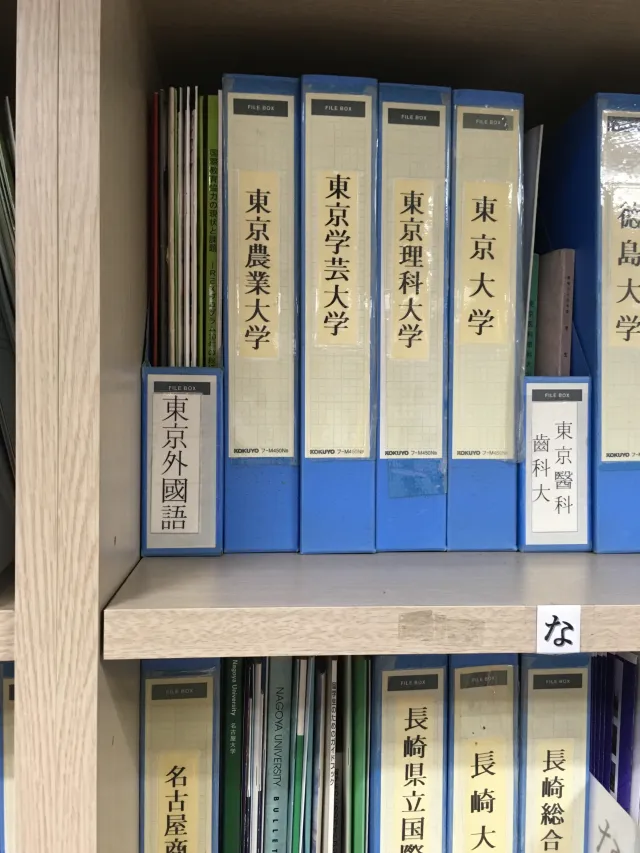
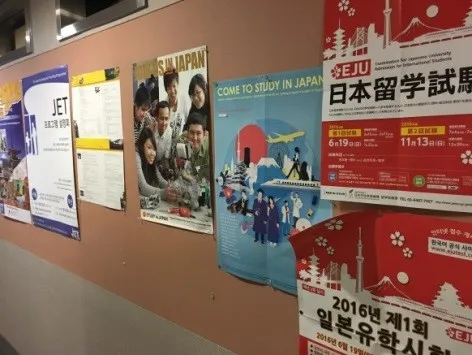
The study abroad consultation office. Here, there are permanent staff holding consultations. There were pamphlets from many different Japanese Universities, including TUFS.
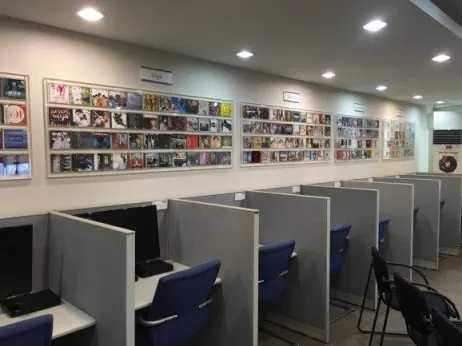
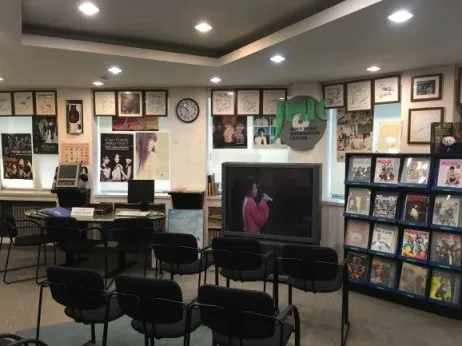
The audiovisual room. Film and concert DVDs are available for free viewing.
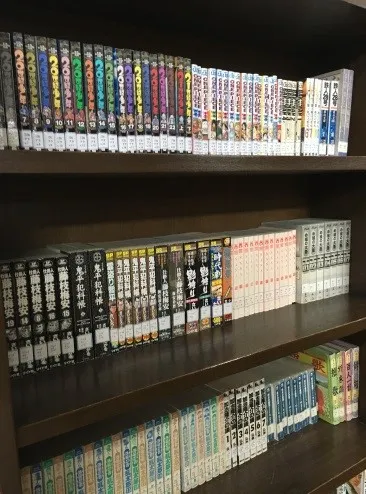
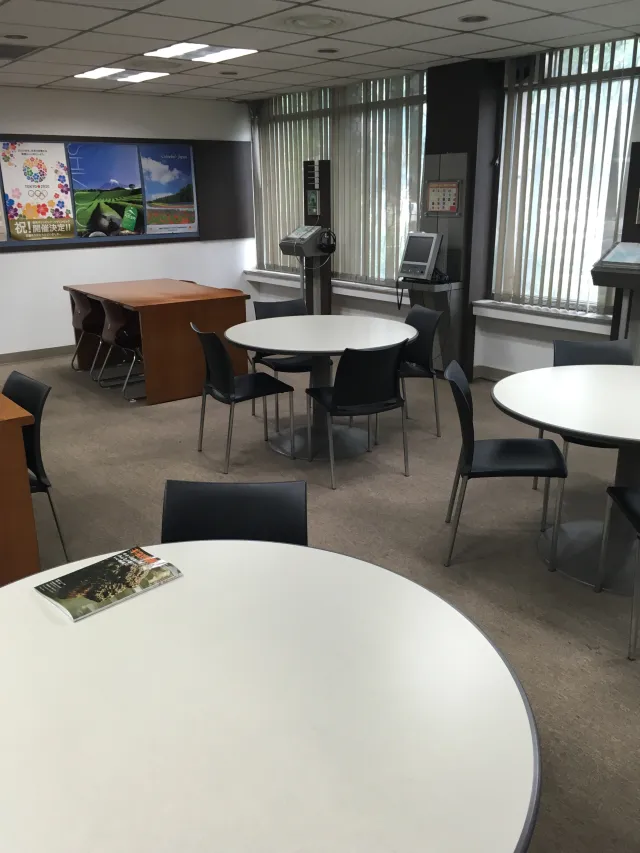
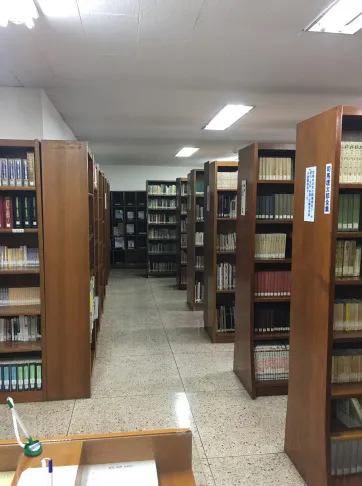
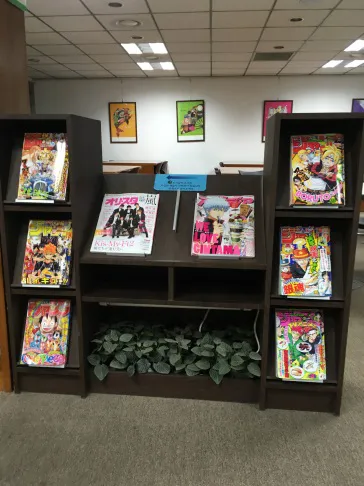
The reading room. Japanese books and comics in Japanese and Korean. There are also recent magazines. The materials can be lent out. On the second floor is the room in which last month’s event was held.
One can easily experience Japanese culture by using smartphones and the internet, but I am delighted that people have the chance to come into contact with it directly at events held by experts on Japan right in the centre of Seoul. I hope that the exhibitions will be high in profit and that many will enjoy experiencing all kinds of Japanese culture at the Information and Culture Institute.
TUFS University President Tateishi Hirotaka and his wife, along with Professor Ikarashi Kouichi were in Seoul, and there was a dinner with of president Kim In Chul of Hankuk University of Foreign studies and his wife. Afterwards, there was a briefing session on the Seoul Office.
July Activity Report
July 2016
Global Japan Office Coordinator
AHN Soyon
Presenters and audience members at the ‘Learn Japanese Culture through Japanese Film’ event held in June were saying about how they would like to experience goldfish scooping, so, when I heard that there would be a Japanese culture event which included goldfish scooping in Seoul, I took a trip to the Japanese embassy in Korea’s Information and Culture Institute, where the ‘Japanese Seasonal Customs Exhibition’ was being held. From Monday 25th July to Saturday 6th August, the gallery on the 2nd floor of the Information and Culture Institute at the Japanese embassy in Korea, viewers could attend the exhibit for free. In the midst of an unprecedented heatwave, a great number of visitors came to enjoy Japanese culture.
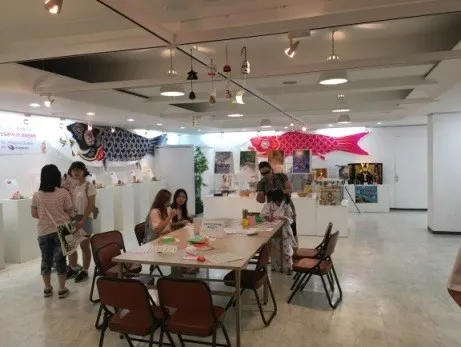
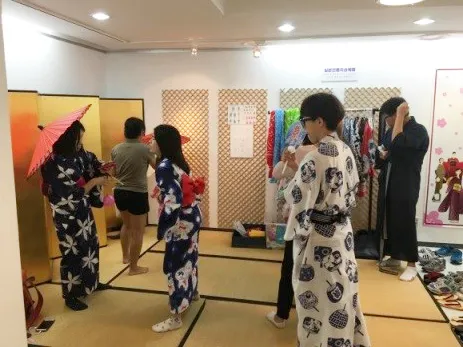
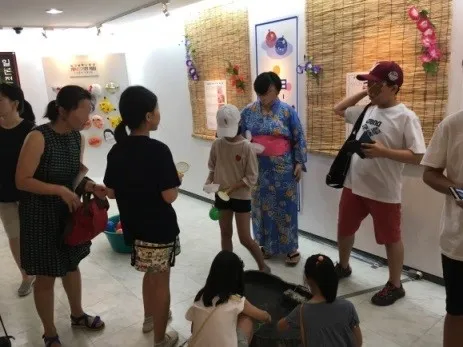
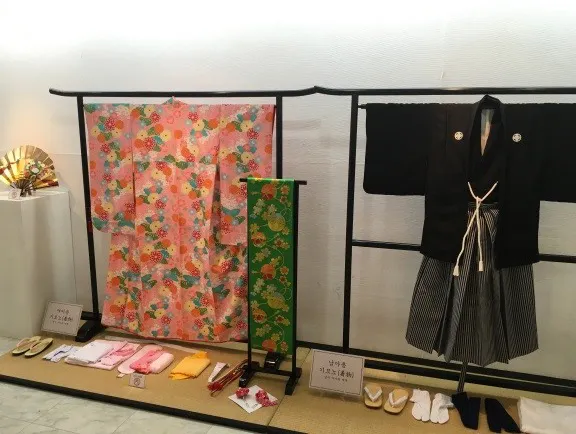
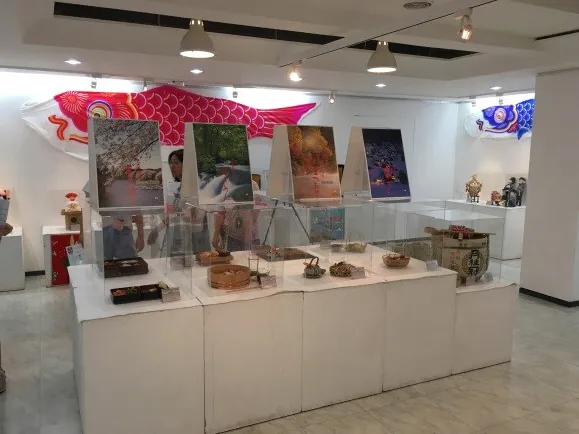
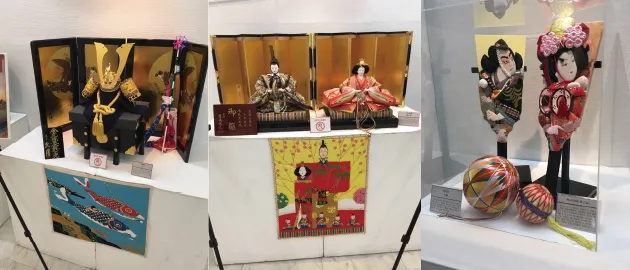
The Information and Culture Institute is in an accessible location around a 10 minutes’ walk from the station, so I handed out pamphlets from the event and sent SNS messages to those who attended the ‘Learn Japanese Culture through Japanese Film’ event encouraging them to take the opportunity to attend this summer holiday.
Although people can easily see and hear about Japanese culture by using the internet, you can’t easily get the experience of directly seeing and feeling it. Most importantly, you can have more faith in events held by the Japanese embassy than you can in unsourced information online. From now on, I hope to plan group field trips to events opening in Seoul like these that allow people to experience things directly.
June Activity Report
June 2016
Global Japan Office Coordinator
AHN Soyon
1. In June are the end of semester tests and on the 3rd of July the JLPT (Japanese Language Proficiency Test) will be held so in terms of this we provided advice regarding study and examinations. In particular there is only one month left before the JLPT so we recommended going over previous notes again and confirming what students have already learned instead of trying to focus on learning new content. As expected students who often watch Japanese dramas or variety television programs have high listening ability, students who often read and study using text have high reading ability so the students seemed happy when I taught them study methods which made use of their strengths whilst improving their weak points.
2. The students who participated in the cultural exchange event last month seemed to become even more interested in Japan through exchanging with the Japanese students. Even students who disliked Japan in the beginning seemed to show signs of interest in Japan. Some opinions from the students which said they wanted to learn about Japanese culture in a fun way and so I decided to introduce the students to Japanese culture through Japanese films and to hold a screening event called “Learn Japanese Culture through Japanese Film”. I asked the students who participated in the cultural exchange event if they were interested in the film screening and also to any students that did not participate in the exchange event but had an interest in Japanese cinema to participate.
I split the 13 participants into 2 groups and decided to introduce “Spirited Away” and “Kikujiro”.
”Spirited Away”
After introducing the characters and the story, I spoke about the topic of hot spring hotels and public bathhouses which appear in the film.
”Kikujiro”
I did the same for “Kikujiro”, introduced the characters, the storyline and choosing the festival scene as my topic, spoke about Japanese festivals or “Matsuri”.

(Thoughts)
-I found out that Japanese films are very interesting.
-I was happy that the process of conducting research also helped my Japanese studies.
-I was able to understand parts that at first I could not due to the research for the speech.
-There were many topics that could have been chosen for the speech from the film so I want to do more research.
-I want to visit the location where the movie was filmed.
-I want to do another speech.
-I felt that watching the film before doing the research and after the research completely changed how the film felt.
-(from students who did not participate in the cultural exchange event) I would very much like to participate in the exchange event and talk about the film.
Even after the cultural exchange event had ended I did not think that it would link to a film speech event. Especially recently the mass media has been reporting about the negative relationship between Korea and Japan but despite this I thought the sight of the students voluntarily choosing to learn about Japan and try to understand Japanese culture was outstanding. Also, I believe holding this kind of speech event prior to conducting a cultural exchange event allows the students to further deepen their understanding of Japanese culture.
May Activity Report
May 2016
Global Japan Office Coordinator
AHN Soyon
We received the contact information of Japanese students from TUFS and are actively beginning to prepare exchange events. Firstly, we searched for Korean students who wanted to participate in the exchange event but over 20 students were keen to participate so we decided to offer the lecture room of a vocational college in Seoul. We then invited the Japanese students and the exchange event was held on the 25th of May. There was a very high level of interest towards the exchange event even from before the schedule was confirmed. The Korean students prepared for the event by practicing their Japanese greetings and self-introductions and conducting research about Japan in order to ask questions to the Japanese students. Even when we were deciding who was going to come and welcome the Japanese students, so many people wanted to come along that we had to decide using rock, paper scissors.
The Japanese students from TUFS also invited their friends and so a total of 7 Japanese students participated in the exchange event. Due to the large number of students participating, we had everyone sit down around 4 tables and after everyone had introduced themselves, they began to exchange with members at the same table. We had the students swap seats every 20 minutes and the lively conversations covered a wide range of topics including their major field of study, dreams for the future, personal stories and introducing the culture of their own countries. The Japanese students introduced games that young people often play in Japan and the Korean students did the same, everyone had a good time playing games together from both countries. Even after the official exchange event had ended, the students swapped contact information and some groups even went out for dinner together.
We were able to get students to proactively participate in the exchange even more than we first expected and especially due to the Japanese students` proficient level of Korean, we were able to hold a lively exchange event without any problems communicating.
*Thoughts on the Exchange event
Korean Students
1. I was surprised by the level of the Japanese students Korean. I also need to study hard so I can speak in Japanese.
2. My negative perceptions about Japan have disappeared.
3. My curiosity towards Japanese culture has grown.
4. I would like to travel to Japan.
5. I would like to participate in another exchange event.
6. Japanese taught by a friend is much more fun and easier to remember than Japanese taught from a teacher.
7. It is much better to learn about Japan through exchanging with Japanese people instead of through the internet.
Japanese Students
1. During our time as students in Korea, it is difficult to find opportunities to interact with Korean people so we were happy to take part in this exchange.
2. It was a good experience and we made some happy memories.
3. I was happy to make friends at the event and I wish to keep in contact with them.
4. I would like to participate in another exchange event.
